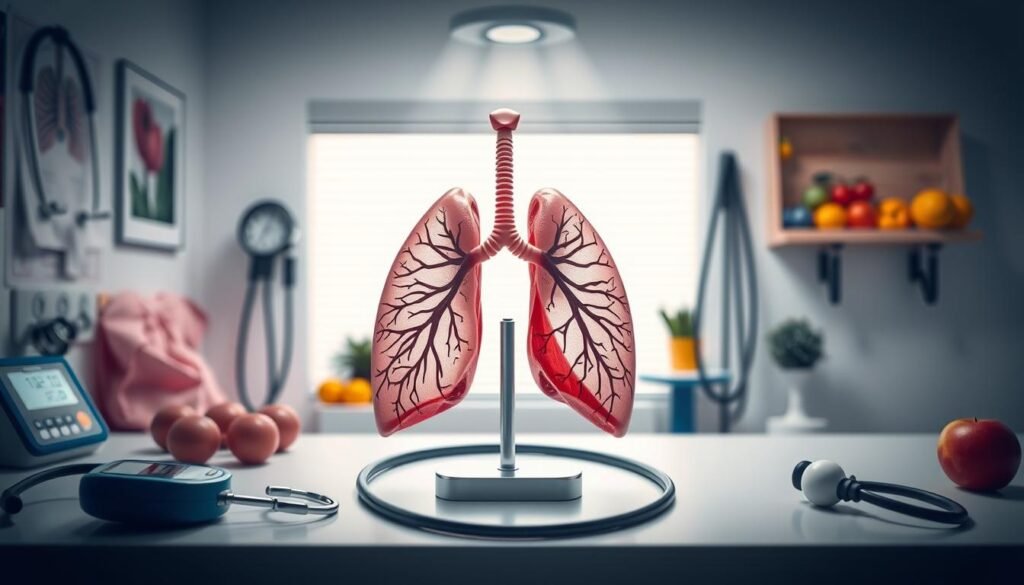The lung cancer survival rate has been around 15% for thirty years. This fact calls for greater awareness of the factors influencing lung cancer prognosis. Lung cancer accounted for about 12.4% of all cancer cases in 2022. This shows the difficulty in fighting this common disease. For both patients and doctors, it’s crucial to understand the disease’s outlook. This knowledge can shape treatment plans and improve life quality.
Many factors affect lung cancer’s prognosis. One important factor is the disease’s stage when found. Finding it early usually leads to better survival rates. The kind of lung cancer, like non-small cell or small cell, also affects the outlook. Each type leads to different outcomes. The treatment given, including surgery and other therapies, further impacts survival chances.
Other aspects include the patient’s general health, age, smoking history, and genetics. These points offer a detailed view of how lung cancer acts in various people. This aids in creating custom treatments. Knowing these things helps patients and their families as they deal with lung cancer.
Key Takeaways
- Lung cancer survival rates have remained stagnant at 15% for the past three decades.
- Early detection and staging significantly impact survival chances.
- The type of lung cancer greatly influences prognosis, especially between NSCLC and SCLC.
- Treatment options available can shift the expected outcomes for patients with lung cancer.
- A patient’s age, smoking history, and overall health are crucial factors in prognosis.
- Understanding these factors helps tailor treatment strategies for better patient outcomes.
The Importance of Prognosis in Lung Cancer
Knowing the future course of lung cancer is vitally important. It greatly affects treatment decisions and helps doctors personalize patient care. Factors like tumor type, weight loss, how active the patient is, and their overall health matter. They help patients and doctors understand what to expect after a lung cancer diagnosis.
Survival rates for lung cancer patients differ. For non-small cell lung cancer (NSCLC), the one-year survival rate can be as high as 74% with certain treatments. But it drops to 52% with other treatments. These numbers show why it’s critical to choose treatments based on personal health information.
Care tailored to each patient is essential. It means looking closely at each person’s specific situation. This approach reduces mistakes or treatment plans that don’t work. The goal is to improve chances of survival and life quality.
Factors Influencing Lung Cancer Prognosis
To improve lung cancer treatment and patient outcomes, understanding certain factors is key. These include the cancer’s stage, patient’s activity level, and overall health. Each plays a role in survival rates and guides the treatment plan.
Understanding Prognostic Factors
For lung cancer patients, certain characteristics can hint at the expected outcome. The stage of the cancer is especially impactful. For example, early stages of non-small cell lung cancer usually have a better outlook than later stages.
Patient’s physical condition is also a major factor; better condition means better outcomes. However, significant weight loss before treatment might lead to a poorer outlook. Overall health is crucial, too, because it affects treatment options like surgery. More details on this can be found here.
Predictive Factors’ Role in Treatment
Predictive factors help understand how well treatments might work. For instance, genetic mutations in lung cancer cells influence the success of targeted therapies. These factors can also suggest when an alternative treatment might be more effective. Identifying these genetic markers helps doctors customize treatment plans for each patient’s unique cancer type.
| Prognostic Factor | Impact on Prognosis |
|---|---|
| Stage of Cancer | Early stages show better outcomes compared to late stages. |
| Performance Status | Higher scores correlate with improved survival. |
| Weight Loss | Significant loss leads to worse prognosis. |
| Overall Health | Better health allows more surgical options, enhancing survival chances. |
| Genetic Mutations | Specific mutations guide effectiveness of targeted therapies. |
Stage of Lung Cancer
Knowing the stages of lung cancer helps in choosing the right treatment. Survival rates are much higher if cancer is found early. For example, the five-year survival rate is 65% for early-detected lung cancer. This rate falls to 3% for stage 4 cancers.
Impact of Early vs. Late Stages
Finding lung cancer early leads to better chances of survival. Early stages like 0 and 1 offer a much improved survival chance. As cancer advances, fighting it off becomes harder. Stage 4 cancer has spread widely, making successful treatment tougher.
Survival Statistics Based on Staging
Survival rates for lung cancer change with each stage. Here are the five-year survival rates:
| Stage | Non-Small Cell Lung Cancer (NSCLC) Survival Rate | Small Cell Lung Cancer (SCLC) Survival Rate |
|---|---|---|
| Localized | 65% | 30% |
| Regional | 37% | 18% |
| Distant | 9% | 3% |
These numbers show the big differences in survival, depending on the stage. Early detection is key to a better outlook.
To understand more about how staging affects life expectancy, see this detailed guide.
Types of Lung Cancer
Lung cancer has two main types: non-small cell lung cancer (NSCLC) and small cell lung cancer (SCLC). Knowing about these types helps doctors choose the right treatment. They can also give patients a clearer idea of what to expect.
Differences between Non-Small Cell and Small Cell Lung Cancer
Most lung cancers are non-small cell lung cancer, making up 80% to 85% of cases. It includes adenocarcinoma, squamous cell carcinoma, and large cell carcinoma. These subtypes are different and respond differently to treatment.
Adenocarcinoma is common in non-smokers and is the most common type. Small cell lung cancer, which is 10% to 15% of cases, is usually linked to smoking. It grows and spreads faster than NSCLC.
Prognosis Variability by Lung Cancer Type
The outlook for NSCLC and SCLC varies widely. NSCLC often has a better chance of survival because there are more treatments available. This includes targeted therapies and surgery.
Meanwhile, SCLC grows quickly and often spreads early, leading to a worse prognosis. Doctors consider the cancer type, its stage, and the patient’s health. This helps predict how well treatment might work and the patient’s overall outlook.
| Cancer Type | Prevalence | Common Subtypes | Typical Prognosis |
|---|---|---|---|
| Non-Small Cell Lung Cancer (NSCLC) | 80% – 85% | Adenocarcinoma, Squamous Cell Carcinoma, Large Cell Carcinoma | Generally Favorable |
| Small Cell Lung Cancer (SCLC) | 10% – 15% | N/A | Poor |
| Other Rare Types | Less than 5% | Adenoid Cystic Carcinoma, Sarcomatoid Carcinoma, etc. | Varies |
The Role of Treatment Options
Effective treatment makes a big difference in lung cancer outcomes. When diagnosed with lung cancer, exploring all treatment paths is vital. These options are key in improving chances of survival and life quality.
Surgical Interventions
For those in early stages, surgery can greatly raise survival odds. It usually means removing the tumor, which might cure if the cancer hasn’t spread. But, a patient’s health and age play a role in whether surgery is an option.
Especially, older patients or those with other health issues might not be able to have surgery. This could limit their treatment outcomes.
Impact of Chemotherapy and Radiation Therapy
Chemotherapy and radiation are crucial for advanced lung cancer. They can shrink tumors and ease symptoms, possibly extending life. The success of these therapies depends on the cancer type and how the patient responds.
For some with severe symptoms, the benefits of chemotherapy are worth the risks. It can make a significant difference in treating lung cancer.
| Treatment Type | Stage | Remarks |
|---|---|---|
| Surgery | Early Stage (I or II) | Potential for cure through resection |
| Chemotherapy | Advanced Stage (III or IV) | May improve survival and manage symptoms |
| Radiation Therapy | Advanced Stage (III or IV) | Can shrink tumors and relieve pain |
| Combination Therapy | All Stages | Utilizes both chemotherapy and radiation for greater efficacy |
Patient’s Age and Its Effects
The age of a patient is key in lung cancer outcomes. Most lung cancer cases are found in older adults. This makes it key to know how age affects treatment success and survival rates. The average age for lung cancer diagnosis in the U.S. is 70 years. This shows how common this disease is among the elderly. As more people get older, the need for lung cancer care that meets their needs grows.
Aging and Lung Cancer Outcomes
About 68% of lung cancer patients in the U.S. are diagnosed after turning 65. This shows how patient age is linked to survival rates. Studies show older patients may not respond well to chemotherapy. They also have more health problems that can interfere with treatment. If early-stage lung cancer isn’t treated in these patients, the average survival is just 14 months. This stresses the need for care plans that consider the patient’s age. As people get older, the stage of the disease and their overall health play a bigger role in what treatment may work.
Age-Related Treatment Considerations
Creating treatment plans for older patients requires thinking about what challenges they face. Often, people over 75 are found to have Stage I lung cancer. Yet, their reaction to treatment can differ from younger people. Surgery is usually the best choice. But, simpler surgeries might be better for some older adults, especially if they have other health problems. More older patients being eligible for surgery shows we need to keep evaluating our treatment plans as patients age.

Putting the focus on a patient’s age when treating lung cancer is critical. This approach can make treatments more effective and boost survival rates for older patients facing lung cancer. For more info, check out the study on how vital patient age is in lung cancer outcomes here.
Smoking History and Prognosis
Knowing how much and how long someone has smoked is key to understanding their lung cancer outlook. If someone has smoked a lot for many years, they might face bigger health problems. It’s vital for doctors and those with lung cancer to grasp this link.
Effects of Smoking on Survival Rates
Research shows that heavy smokers don’t live as long as non-smokers. Those who’ve smoked more than 61 packs a year are more likely to see their lung cancer come back. They also don’t live as long overall. Older patients tend to smoke more than younger ones, making age an important factor in lung cancer survival talks.
Smoking Cessation Benefits
Quitting smoking helps lung cancer patients a lot. Stopping smoking can make recovery better and help people live longer after treatment. Not smoking for a long time improves how well lungs work. Those who quit smoking do better than those who keep smoking. This shows quitting smoking is crucial for a better lung cancer outlook.
Overall Health Status
When it comes to lung cancer prognosis, checking a patient’s overall health is key. A thorough health check helps doctors understand if a patient can handle tough treatments like chemo and surgery. Patients in good health often do better with these treatments, leading to better results.
On the other hand, patients not in good health might face problems. These issues can make treatments less effective.
Assessment of General Health in Prognosis
Doctors use different ways to check the health of lung cancer patients. They look at how fit the patient is, their nutrition, and mental health. This check-up is crucial for choosing the right treatment.
Knowing the patient’s health helps doctors tailor treatments. This can mean better chances of beating lung cancer.
Impact of Comorbid Conditions
Having other illnesses like heart disease or diabetes can make lung cancer prognosis worse. Patients dealing with other health problems often struggle more with cancer treatments. Studies show these patients might not respond as well to treatment and may have lower chances of survival.
It’s very important to manage these other illnesses. Doing so can improve the patient’s health and the success of their cancer treatment.
| Comorbidity | Impact on Lung Cancer Outcomes | Treatment Consideration |
|---|---|---|
| Cardiovascular Disease | Increased treatment risks and mortality | Intensive monitoring and supportive care |
| Diabetes | Reduced immunity and wound healing | Strict glycemic control is necessary |
| Chronic Lung Disease | Higher likelihood of respiratory complications | Adjust treatment regimens for safer management |

Genetic Factors in Lung Cancer Prognosis
Understanding how genes affect lung cancer is key to fighting the disease. By identifying genetic mutations, doctors can figure out the best treatment plans for each patient. This makes treatment more personal and effective.
Thanks to advances in research, doctors can use targeted therapies. These therapies are more likely to succeed in managing lung cancer.
Genetic Changes and Treatment Responses
Genetic changes can greatly influence how a patient reacts to treatment. Some mutations might make the prognosis worse, while others could lead to better outcomes. Knowing these factors helps doctors create treatment plans that could increase a patient’s chance of survival.
Importance of Tissue Testing
Tissue testing is crucial for spotting genetic changes in lung cancer. It lets health experts see which mutations are in a tumor. This step is vital for choosing the best treatments based on each patient’s genetic makeup.
| Type of Genetic Factor | Impact on Treatment Responses | Importance in Prognosis |
|---|---|---|
| Mutations (e.g., EGFR, ALK) | Targeted therapies can be utilized | Help predict treatment outcomes |
| Gene Expression Changes | Affect sensitivity to certain drugs | Can indicate likelihood of disease progression |
| Inherited Genetic Factors | Potential for increased risk of lung cancer | Highlights familial patterns of the disease |
Environmental Exposure and Lung Cancer
Environmental factors are key in lung cancer development. Various pollutants increase lung cancer risk. Knowing how these elements link is essential for preventing lung cancer and bettering prognosis.
Risk Factors Linked to Environment
Many studies show the dangers of environmental exposure. Past lung diseases can make a person more likely to get lung cancer. For example, asthma raises the risk significantly.
Jobs that expose people to dangerous chemicals like asbestos and heavy metals also pose a big risk. If you work in places with bad air, you should be cautious.
Having family members with lung cancer affects your risk too. This points to both genetic factors and environmental effects. The risk is higher when there’s a history of lung diseases in the family.
Long-term Effects of Air Quality
Poor air quality over time can harm lung health. Research shows a clear link between air pollutants and lung cancer rates. Radon exposure alone causes around 21,000 lung cancer deaths each year.
Knowing the risks tied to air pollution can lead to better air quality. This understanding is crucial for lung cancer prevention. Exploring these issues further can help in finding ways to protect against lung cancer.

Conclusion
Understanding what affects lung cancer’s outcome is key to better care and longer survival. Factors like the cancer’s stage and type matter a lot. For example, studies show that being female or having anemia changes survival chances.
Also, certain biomarkers predict how well treatments might work for advanced lung cancer. Tests before surgery can reveal more about a person’s specific cancer. This helps doctors create treatments just for them.
Research keeps finding new info to help lung cancer patients. By focusing on important factors, doctors can make better treatment plans. This can improve care and help patients live longer.